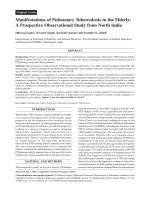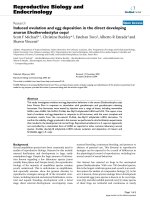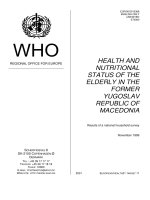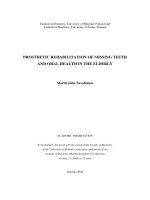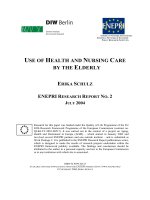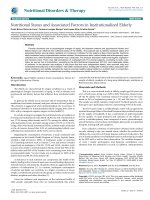Falls and Fall Prevention in the Elderly: Insights from Jamaica ppt
Bạn đang xem bản rút gọn của tài liệu. Xem và tải ngay bản đầy đủ của tài liệu tại đây (359.58 KB, 46 trang )
Falls and Fall Prevention in the Elderly: Insights from Jamaica
Kenneth James
Jacqueline Gouldbourne
Chloe Morris
Denise Eldemire-Shearer
Department of Community Health and Psychiatry
Mona Ageing and Wellness Centre
University of the West Indies
Mona, Jamaica
2
Abstract
Falls among the elderly is
increasingly being recognized as an issue of concern in both
developed and developing countries. Falls in the elderly may precipitate adverse physical,
medical, psychological, social and economic consequences. In Jamaica, there are no
exhaustive studies or literature that have fully captured the epidemiology, aetiology or
impact of such falls, though there is evidence to suggest that it is an issue that warrants
some attention.
This paper, through the use of quantitative and qualitative methods sought to gain
insights on the situation regarding falls among the elderly in Jamaica. Through literature
reviews, canvassing of medicals records, conducting focus groups and interviews,
perspectives were gleaned on falls among elderly persons in Jamaica. Contributory and
risk factors, and perceptions and costs were explored, as were any existing fall prevention
policies or policy thrusts. The emerging picture is that falls are not a rare occurrence
among older persons in Jamaica and extrinsic factors such as poor road surfaces, poorly
constructed steps and poor design of public transportation vehicles etc. are factors that
cause falls in the local setting. Similarly, intrinsic factors related to co-morbid condition
such as hypertension, diabetes and sensory impairment appear to also contribute to
increased risk of falling.
Further research on the issue is needed in Jamaica. So too are specific fall prevention
policies and programs and actions to address prevailing concerns. Increased awareness
of the occurrence of falls among the elderly and mobilization of efforts to decrease such
events is needed, complemented by culturally relevant health education and promotion
activities. Synergistic efforts of government, civil society, seniors and communities and
households will be required for successful fall prevention. The time for planning and
action is now.
3
Falls and Fall Prevention in the Elderly: Insights from Jamaica
Introduction
A fall can be defined as “unintentionally coming to rest on the ground or other lower
level with or without loss of consciousness”. [1] Falls among the elderly remain an ever-
increasing problem. Age-related changes and disease both have an impact on an older
person’s ability to balance. Similarly, cognitive impairment, various medications, and
changes in a person’s environment all appear to contribute to increased risk of falling. [2]
Falls in the elderly are a public health and community problem with adverse physical,
medical, psychological, social and economic consequences. These include disability and
deformity, fear of repeated falls, curtailment of routine social activities, direct costs of
medical care associated with injuries and loss of potential income.
Current literature suggests that the problem is of concern in both the developed and the
developing world. In Australia it is estimated that about a third of the elderly living in the
community experience at least one fall annually. [2] Gillespie citing studies from the
USA corroboratively asserts that that more than 30% of people aged
65 or older living in
the community fall each year, and that the risk of falling increases with age. [3] Statistics
from Ontario, Canada indicate that one-third to one-half of persons over 65 are prone to
falling, with falls being more common in older females. [4]
4
From the developing world, data are now emerging that suggest falls among the elderly is
a growing problem and of significant public health concern. Falls in the elderly in China
has been described as a very common complication in social life. [5] Based on a
prospective cohort study in Hong Kong among older adults, the prevalence and incidence
of falls were determined to be 19.3% per year and 270 per 1000 person-years
respectively; with recurrent falls happening in 4.75% of Chinese older adults every year.
[6] In Africa, one population-based survey from Tanzania that examined the injury
morbidity in an urban and a rural setting indicated that among persons over sixty years
old, falls accounted for about 35% of reported injuries in both settings. [7] In Latin
America and the Caribbean, analysis of data from the SABE (Salud, Bienestar y
Envejecimiento en América Latina y el Caribe) study on Aging, Health, and Well-being
conducted in seven cities across the region, reported the prevalence of falls as varying
from 21.6% in Bridgetown (Barbados) and 29% in Havana (Cuba) to 33% in Mexico
City (Mexico) and 34% in Santiago (Chile). [8]
The number of elderly is increasing most rapidly in Asia, Latin America, the Middle
East, and Africa. Developing countries will continue to experience rapid population
aging in the coming decades and by 2025, there will be 839 million older people living in
developing countries, 500 million more than will be living in developed countries. [9]
Melton [10] has predicted that the aforementioned regions will account for over 70% of
the 6.26 million hip fractures expected in the year 2050. Moreover, about 90 percent of
hip fractures are associated with a fall, with the vast majority of such falls being from a
5
standing height or less. [11]. Consequently, there is increasing imperative to address falls
and fall prevention among the elderly in developing countries such as Jamaica.
Background and Rationale
The Caribbean has been identified as the most rapidly ageing region of the world.
Between 1960 and 1995, there was a 76.8% increase in the elderly population. [12]
Among its regional island states, the average growth rate in the elderly population was
approximately 5.3% for the 1995-2000 period. The elderly as a percentage of total
population was 4.3% in 1950 and is estimated to reach about 15% by 2020. [13] In
Jamaica, a similar pattern has been observed with a clear and rapidly rising trend in the
elderly as a proportion of the population (See Figure 1).
Figure 1.
Constructed using data from
Elderly (60 years and over) as a percentage
of total population with time, Jamaica
5.0%
10.0%
15.0%
20.0%
25.0%
30.0%
1850 1900 1950 2000 2050
Year
6
By 2025 as much as 1 in 7 persons will be elderly. Moreover, characterizing this pattern
of increasing elderly is the differential growth rates within the various sub-age groups
over age 60, with the 75 years and above age group expected to double moving from
2.8% currently to 4.0 % in 2025.
Concomitant with the increase in elderly as a percentage of the population has been the
epidemiological transition where the leading causes of morbidity and mortality are no
longer infectious in nature but reflect the rise and predominance of chronic diseases such
as hypertension, diabetes and osteoarthritis. These conditions, are commonly known to
increase risk of falling, providing further rationale for the assessment of, as feasible, the
situation regarding falls and fall prevention in the elderly in Jamaica.
Aims and Objectives
This paper will focus on the situation regarding falls and fall prevention in Jamaica. Its
primary objectives are to describe and review as far as current documentation allows:
(1) the epidemiology of falls;
(2) health service impacts and costs;
(3) interventions and policies regarding fall prevention; and
(4) to elucidate and illustrate the situation regarding falls and fall prevention in
Jamaica through qualitative insights based on a number of case histories and
observations.
7
Methodology
Anecdotal evidence suggests that falls in the elderly is prevalent. The extent to which the
literature from Jamaica provides supporting empirical evidence is not fully known and is
perhaps sparse. Consequently a collective decision was taken by the research team to
employ a number of methods and strategies to provide evidence and insights regarding
falls among the elderly in Jamaica. These included a search and review of existing
literature, docket and patient information reviews, focus groups, interview with an expert
and case histories. To this end, tools were designed to elicit information from focus
groups, individual clients and patient records. The tools are attached at appendix 1-3.
Search Methodology
A comprehensive literature search was done. Scrutiny of articles from Caribbean and
Latin American publications was conducted to ensure the inclusion of as many relevant
published and unpublished studies and records that are pertinent to falls in the elderly.
Searches on multiple electronic databases were done. These included Medline, MedCarib
and PubMed. Internet searches, as well as manual checks of reference sections of review
articles and studies published in the last ten years, including review of the published
articles in the West Indian Medical Journal and the Post Graduate Medical Journal of the
Caribbean.
Document Selection
Documents were screened to ensure appropriateness for inclusion in this study. The steps
followed appear below.
8
Step 1: Identification of relevant documents
Documents were identified from the electronic data base that could potentially be used in
the review. Duplicate studies were removed as well as studies unrelated to falls in the
elderly (e.g., documents that referred to “fall” as a season or falls in children). To further
ensure coverage of the topic documents related to trauma and fractures were also
included to deduce how many of these are resulting from falls.
Step 2: Screening Based on Initial Inclusion/Exclusion Criteria
Studies located in Step 1 were screened based on inclusion/exclusion criteria, as outlined
in the table below. All documents retrieved in Step 1 were screened based on title and
abstract. Documents were omitted from the next level of screening if they failed to meet
all of the inclusion criteria, or met at least one of the exclusion criteria (see Table 1).
Table 1: Inclusion/Exclusion Screening Criteria
Inclusion Criteria Exclusion Criteria
1. Topic: Related to fall or fall injury
2. Age Group: Seniors (majority of
participants 60 years or older)
3. Languages English
4. Settings: Caribbean and Latin
American based.
1. Studies that target children or youth
2. Studies predominantly based on records
of persons under 60 years of age.
3. Records of trauma unrelated to falls.
4. Studies based in other geographic
regions.
9
All records and documents that met the relevance criteria were retained for the data
extraction phase of the review process.
Review of patient/client records
To obtain clinic-based data regarding falls among the elderly. The records from a typical
community health centre/ primary care clinic were reviewed. The dockets and the
summary diagnoses registers of patients attending the Social and Preventive Medicine
(Hermitage/August Town) clinic between January 2004 and September 2006 were
eligible for study. The clinic serves a catchment area with a population of 35,920 persons
with the majority of communities falling in the low- to middle-income categories. The
dockets and records for the period covered some fifteen thousand, four hundred and fifty
(15,450) person-visits. From these, dockets of patients 60 years and over were selected
and reviewed to ascertain whether the visits were in any way fall related. Additionally,
from the summary daily register which records visits and diagnoses and which uses both
ICD-9 and ICD-10 coding, all diagnoses related to trauma, dizziness/vertigo,
hypertension, diabetes, cardiac disease, cerebrovascular disorders, epilepsy and arthritis
were also selected for examination and the dockets reviewed for any history of falls
during the period studied. This approach was necessary since falls are not necessarily
recorded as a diagnosis but may be included in the medical history as a presenting
complaint associated with these primary diagnoses.
All relevant records were retained for the data extraction phase of the review process.
The Data Extraction Form (Appendix 1) was developed based on the researchers'
knowledge of falls. The data extracted included information on medical history; date,
10
time and circumstances of the fall; type of injury resulting from fall; consequences and
outcomes resulting from the fall, and where possible economic costs associated with the
fall.
For quality control, two reviewers extracted the information for each document and
compared results. Any differences were resolved through discussion. The data extracted
were entered into a spreadsheet, analyzed and summarized with help of the software
package, Statistical Package for the Social Sciences (SPSS version 12.0).
The research team also sought to complement its work by an interview with an expert
physiotherapist who saw patients reporting for treatment and physiotherapy services
secondary to falls. By reference to fall-related physiotherapy visits during the preceding
1 year period, the expert provided further opinions, insights and data, based on
experience at the University Hospital of the West Indies, the leading tertiary care and
medical teaching institution in the island. This activity essentially provided a perspective
on falls in the elderly based on hospital outpatient derived data.
Focus Groups and in-depth Case interviews
To augment the quantitative data obtained from the literature review and the review of
records, focus groups and case interviews were done. The focus groups sought to obtain
information, opinions and perceptions regarding: characteristics of fall, intervention
approaches, risk factors, outcomes of falls and prevention implications. The participants
for the focus were recruited through the National Council for Senior Citizens which
liaises with and works extensively with persons 60 years and over throughout the island;
11
and which also networks closely with government, non-governmental organizations and
civil society on matters related to the elderly.
Four focus groups were held. The participants were selected so as to gain broad
representation from the varying backgrounds spanning the socio-economic gamut found
in the island. The focus group discussions were recorded, transcribed and the text read to
familiarize the researchers with the content. Content analysis then ensued by
identification of common themes and ideas expressed. These were then summarized and
are reported in the results section of this paper.
In addition to the focus group, three in-depth interviews of persons who fell within the
past year were done. This was done to further elucidate the situation regarding falls as in
many cases, medical records were curt and without details about the fall itself. These case
histories/in-depth interviews provided windows to the confluence factors that result in a
fall, helping to illustrate ‘the pathway to falls’ and the contexts in which they occur.
In an attempt to address the issue of fall prevention policies and interventions, the
research team enquired about any existing relevant national level documents. A review of
the National Policy for Senior Citizens as well as the National Policy for Disabled
Persons was conducted. In the absence of specific national policy directly concerned with
falls and fall prevention among the elderly, these were deemed to be policy documents
that might be relevant.
12
Results
From the literature search, two seminal papers pertinent to falls in the elderly in Jamaica,
were identified. These were Patterns of trauma injuries in rural versus urban Jamaica
[14] and Falls: A modifiable risk factor for the occurrence of hip fractures in the elderly.
[15] The former study was conducted between March 1, 1998 and April 30, 1998 at the
University Hospital of the West Indies (urban area) and at the St. Ann’s Bay Hospital
(rural area), among 974 patients and 458 persons admitted to the surgical services of
these hospitals respectively. At these institutions respectively, 22% (185) and 19 % (101)
of admissions were due to trauma, with elderly persons (60 years old or greater
accounting for 10.5% of such admissions. Additionally, data from that study indicate that
falls was the second leading cause of unintentional injury accounting overall for 31.5% of
unintentional injuries seen (26% at UHWI and 41 % at The St. Ann’s Bay Hospital) .
While the exact numbers and proportions attributable to falls were not disaggregated by
age group in the data reported, the authors [14] highlighted the fact that “falls were
confined to two groups, the elderly who usually fall at home in urban as well as
rural areas, and young children who fall from trees in rural areas”. In recognition of the
problem among the elderly, a public campaign to emphasize measures to provide a safer
home environment and minimize the injuries sustained from falls was recommended.
Williams-Johnson, Wilks, and McDonald further illuminate the situation regarding falls
among the elderly in Jamaica. [15] In examining the trauma registry records of the 152
hip fracture patients presenting at the University Hospital of the West Indies in Jamaica,
between January 1, 1998 and December 31, 2001, they showed that in 90% (137) of
13
patients diagnosed with hip fractures, the precipitating factor was a fall. More strikingly,
the overwhelming majority of these persons were aged 65 years-old and greater. The data
on the distribution of falls by age group is displayed in the pie chart below (Figure 2).
Figure 2:
Constructed using data from Williams-Johnson JA, Wilks RJ, McDonald AH.
West Indian Med J. 2004 Sep;53(4):238-41.
With regard to the place of occurrence of falls resulting in hip fractures, for elderly
persons 65 years-old and over, the home was the predominant location of the fall,
implicated in over 80 % of cases. Figure 3 shows the distribution of falls by place of
occurrence for the patients presenting with hip fractures.
Age distribution of persons presenting with hip fractures subsequent
to falls at the University Hospital of the West Indies,
Jamaica (1998-2001)
9%
91%
Age ≤ 64 years
Age≥ 65 years
14
Figure 3:
Constructed using data from Williams-Johnson JA, Wilks RJ, McDonald AH.
West Indian Med J. 2004 Sep;53(4):238-41.
Interestingly “places of abode or residence” (i.e. home or nursing home) where it is likely
that the majority of time in a typical day may be passed were specifically identified as the
site of the fall (87.6% of cases). Among the elderly, further examination of factors within
the home environment as well as personal medico-physical factors is warranted if the
occurrence of falls among these persons is to be reduced.
In trying to capture the typology and aetiology of falls among older persons, various
rubrics have emerged such as “accidental” and “non-accidental” causes. Increasingly
studies [1, 16, 17] now classify the factors associated with falls/causes of falls as
81.8%
3.3%
5.8%
1.7%
7.4%
0.0%
20.0%
40.0%
60.0%
80.0%
100.0%
Home Street Nursing
Home
Public
Place
Other
Distribution of falls by location among persons presenting
with hip fractures subsequent to falls at the University
Hospital of the West Indies, Jamaica (1998-2001)
15
“extrinsic” and “intrinsic”. Extrinsic factors or causes refer largely to environmental
phenomena (e.g. rugs, floor surfaces, pathway obstacles, potholes). Intrinsic factors or
causes on the other hand relate to age-associated physiological changes, disease or
medications. Within the Jamaican environment, combinations of extrinsic and intrinsic
factors contribute to the occurrence of falls.
In the analysis of extrinsic factors associated with hip fractures most of which were due
to falls and most of which occurred in elderly persons, the Jamaican data presented by
Williams–Johnson et al [15] yields the following. Of 137 patients who fell,
approximately 16% fell from a bed or a chair/stool, while about 8% tripped over objects
such as boards, garden hose, slippers, loose carpet, and electrical wires. In of about 58%
of cases, the location/activity associated with the fall was not stated. However, about 14%
were associated with slips in the bathroom.
With regard to intrinsic factors, conditions such as hypertension (37%), diabetes mellitus
(21.7%), chronic ischaemic heart disease (7.6%), dementia including Alzheimers disease
(7.6%) were the main illnesses noted among the patients who fell. Less commonly
reported were loss of vision in one eye, cataracts, and seizure disorders. [15] While no
cause-effect relationship could be authoritatively established from the study, the co-
existence of both intrinsic and extrinsic factors in the patients studied allude to the multi-
factorial causation of falls and to the dynamic interplay of environment, physiological
impairment, physical illnesses, and activities being pursued.
16
Review of Health Centre records: findings
Twenty-seven cases of falls were identified from the review of the records of 5412
person-visits by individuals 60 years and over to the health center during the 33-month
period, January 1, 2004 to September 30, 2006. Among these 27 persons the age range
was 61-82 years with a mean age of 71.3 years (s.d. = 6.1, median = 70 years). The age
distribution is shown in Figure 4 below.
Figure 4
.
By gender, 66.7% of the cases seen at the health centre were females; males comprising
the remaining 33.3%. This ratio is in keeping with the national observed pattern of
utilization of clinic health services where 66 % of users are females.
60 65 70 75 80
Age (yrs)
0%
10%
20%
30%
P
e
r
c
e
n
t
Age distribution of persons 60 years and over
attending the Hermitage /August Town Clinic
for falls (Jan. 2004- Sept.2006)
17
Diagnoses, co-morbid illnesses and disability
Of the 27 files perused, 5 had a primary diagnosis of vertigo/dizziness of unknown cause,
two -fractures; one-epilepsy; and two had the diagnosis of “falling”. The remaining 17
(63%) were listed as various cases of trauma or injury to the body parts.
Co-morbid illnesses relating to the fall or attendant in the persons who fell are displayed
in Table 2 below. Diabetes and hypertension, hypertension and diabetes, hypertension
with heart disease were the most common mix of co- morbid diagnoses.
In fact, diabetes and hypertension were simultaneously present in 30.6 % of those elderly
who fell; and either diabetes or hypertension was a co-morbid condition in 67.6% of fall
cases presenting to the health centre studied. Overall, only in 14.8% of the fall cases
studied, were there no documented co-morbid conditions.
Table 2. Co-morbidity among elderly persons who presented at the
Hermitage/August Town health centre for falls
(Jan.2004-Sept.2006)
Illness
Frequency
Percent
Diabetes 1 3.7
Diabetes & Hypertension 5 18.5
Diabetes & Hypertension, heart
disease
4 7.4
Diabetes & Hypertension &
mental illness
1 3.7
Diabetes & Hypertension &
another illness
1 3.7
Hypertension 5 18.5
Hypertension, heart disease 3 11.1
Hypertension, heart disease &
mental illness
1 3.7
Heart disease 1 3.7
Other neuro-psychiatric
conditions
1 3.7
No co-morbid condition
recorded
4 14.8
Total 27 100.0
18
Regarding specific physical disabilities and impairments, impairment of sight was noted
in 11.1% of cases and a similar proportion had hearing impairment. Mobility problems
were documented for 22.2% of elderly persons who fell. No disability or other physical
impairment was reported for 51.9% of those elderly who fell.
Figure 5:
Injury to body parts
The lower limb was the most frequently injured area of the body during falls (injured in
52% of cases studied). There were two head injuries and one eye injury secondary to
falling. The bar chart below illustrates the relative frequency of the injuries by body part.
Figure 6
Physical disability/impairment among elderly persons
presenting to the Hermitage/ August Town Health Centre
(Jan.2004 - Sept.2006)
Sight, 11.1%
Hearing, 11.1%
Mobility, 22.2%
None, 51.9%
0%
5%
10%
15%
20%
25%
30%
35%
40%
Head Back Arm Knee Leg Chest Eye
Injury secondary to falling by body part
(n=27)
19
Place where the fall occurred
The place where the fall occurred was not recorded in most cases (~78%). In the few
instances where this was recorded, places mentioned were the public bus, or in the
home/yard environment (over a dog, at the gate, climbing stairs and inclines)
Consequences (medical) of fall
The immediate impact and consequences from the falls seen in health centre were
laceration needing cleaning and dressing (85% of cases). These cases also complained of
pain from tissue damage. For some patients the wounds resulted in difficult to heal,
chronic leg ulcers requiring frequent cleaning and dressing at the health centre.
Insights from expert physiotherapist based on hospital outpatient data
Insights on elderly outpatients attending the physiotherapy department consequent to falls
were obtained through the collaborative interview of an expert physiotherapist. This
provided a window into characteristics of fall cases seen in a hospital ambulatory setting.
This data further complements the hospital derived data gleaned from the literature and
has the advantage of providing post-hospital discharge data where the consequences and
impact of falls are further illuminated.
For the twelve–month period October 2005 to September 2006, twenty-nine (29) cases
were identified from the outpatient physiotherapy department of the hospital. Nine (31%)
were male and 20 (69%) were female.
20
Their ages ranged from 62 years to 94 years; the mean age being 72 years (s.d. = 9.7). As
in the cases obtained from the health centre, the median age was also 70 years (inter-
quartile range: 63-76). Figure 7 below is a pictorial representation of the age distribution
of the cases seen at the outpatient physiotherapy department. The distribution reflected
some skewness to the right, suggesting the median as the preferred measure of central
tendency.
Figure 7: Age distribution of elderly patients seen at hospital outpatient physiotherapy
department for falls (Oct:2005 –Sept 2006)
62 64 66 68 70 72 74 76 78 80 82 84 86 88 90 92 94
Age
0%
10%
20%
30%
P
e
r
c
e
n
t
21
Injury following fall
The majority of patients (79.3%) seen sustained a fracture. Fractures of the lower limb
were noted in 48.2% of the cases and fractures involving the upper limb occurred in
27.5% of the cases. In approximately one in six cases muscular pain and other damage
was the main cause of referral for physiotherapy. The distribution of injuries is shown
below in Figure 8.
Figure 8
Co- morbidity
Among those clients of interest seen for physiotherapy, diabetes mellitus and
hypertension predominate as co-morbid conditions. This pattern was similar to that
observed at the Hermitage August Town Community Clinic. Diabetes or hypertension
Distribution of injury sustained after a fall among elderly
attending outpatient physiotherapy department post-
hospitalization (Oct. 2005-Sep.2006)
0.0%
10.0%
20.0%
30.0%
40.0%
50.0%
Fracture: arm Fracture: leg Fracture; arm
and leg
Injury to back Muscular pain
and other
damage
22
was a co-morbid condition in 51.6% of cases. Notably however, there was an increased
prevalence of cancer (6.8%) among these elderly who fell and were seen for
physiotherapy in the hospital outpatient setting as compared to those seen at the health
center level. The finding is not surprising given the somewhat different and more severe
morbidity that would be expected among those who had been admitted to hospital
vis-à-vis clients obtained from a community clinic setting. Table 3 captures the
distribution of attendant co-morbid conditions.
Table 3: Prevalence of co-morbid conditions among elderly patients
experiencing falls seen at outpatient physiotherapy department
(Oct. 2005 – Sept. 2006) [n=29]
Place of fall
Figure 9 displays the pattern of falls by place. The house was the most frequently
documented site of falling accounting for 52% of the location of fall for those persons for
whom site was recorded and at least 38% overall of the falls among the clients studied.
Co-morbid condition %
Diabetes 3.4
Diabetes & Hypertension 10.3
Diabetes, Hypertension &
Heart Disease
6.9
Hypertension 20.7
Hypertension & Heart
Disease
10.3
No co-morbid condition
documented
31.0
Asthma 3.4
Cancers 6.8
Gastric ulcer 3.4
Scoliosis 3.4
Total 100.0
23
Twenty- eight percent (28%) cases said they fell outside within the yard or home
environs while only 3.4% of falls occurred at work. In 28% of cases the site of the fall
was not recorded.
Figure 9:
Distribution of place of fall among elderly patients experiencing
falls seen at outpatient physiotherapy department
(Oct. 2005 – Sept. 2006) [n=29]
House
38%
Outside: In
yard/home
environs
28%
Road
3%
At work
3%
Not stated
28%
Consequences (medical) of fall
The majority of persons, 66% (19), suffered marked immobility from the injury they
sustained when they fell. This immobility coexisted with severe pain. One person who
worked full time work was medically unfit to attend work for some days. All other
persons were retirees.
Persons who fell and sought attention at the hospital underwent a variety of medical
treatments and procedures. All cases had radiological investigations (X-rays) of the
24
injured areas. Sixty-two percent (18) of the cases had surgical operations done. In a
minority of instances (10.3%), CT scans or ultrasound investigations was required. All
cases subsequently attended orthopaedic and physiotherapy therapy clinics. The number
of visits made by the clients reviewed ranged from 1 to 24; the median number of visits
being 4 (inter-quartile range: 2.75 – 8).
Health impact and social/economic burden of falls
The impacts of falls among the elderly are manifest in a variety of ways. It is useful to
recognize that falls among the elderly not only incur directs cost clearly associated with
the falls, but also indirect costs and intangible costs. Direct costs include those associated
with the cost of medical care. Indirect costs include: the loss of income and productivity
associated with the fall, those of absenteeism from work, and losses from disability. It is
important to note that even though many elderly are retired persons, they continue to be
productive citizens contributing economically through self-employed activities,
agricultural endeavours, and their roles in many households as caregivers, and
grandparents. A fall of an elderly person can thus result in significant indirect costs.
Additional indirect costs include those of increased insurance premiums as well as those
of increased payments to beneficiaries when an insured person is injured. Intangible
costs occur due to pain and suffering or due to fear of falling again. This can disrupt the
normal routine and social activities of older persons. Falls among the elderly may
necessitate a disruption role changes that can negatively impact a family or household.
25
While the indirect and intangible costs are difficult to measure, preliminary insights into
the direct cost of falls can be gained by examination of the data presented below in Table
4. The data was obtained through information gleaned from patient records studied from
the community clinic (health centre) and those from the physiotherapy outpatient clinic
supplemented by case interviews with persons who had fallen and utilized these services.
Table 4: Minimum estimates of economic cost of falling in clients studied
Procedure
Minimum
costs
# of Health centre
cases utilizing
procedure or
service
Total
(Jamaican
dollars)
®
# of Physiotherapy
cases
utilizing procedure
or service
Total
(Jamaican
dollars)
®
X Ray
CT Scan
Ultra Sound
MRI
Surgery
Dressings
Health centre visits
Physiotherapy
Out Patient Clinic
Accident & Emergency
Pain Medication
Antibiotics
$1,500.00
$12,000.00
$4,000.00
$50,000.00
$20,000.00
$ 200.00
$ 100.00
$950 00^
$500.00
$500.00
$500.00
$1,000.00
15
27
27
27
27
22,500.00
5,400.00
2,700.00
13, 500.00
22,000.00
29
1
2
1
18
18
114*
7
29
29
23
43,500.00
12,000.00
8,000.00
50,000.00
360,000.00
3,600.00
108,300.00
3,500.00
14, 500 .00
14,500.00
23,000.00
Total $66,100 $626,400.00
^Represents the weighted average of a first visit of $2000 and 3 follow-up visits of $600 (recall typical
number of visits = 4)
* represents no. of person-visits for physiotherapy services
® N.B. To convert costs into US$, divide by 66. [$1US = 66 Jamaican dollars (J$)]



